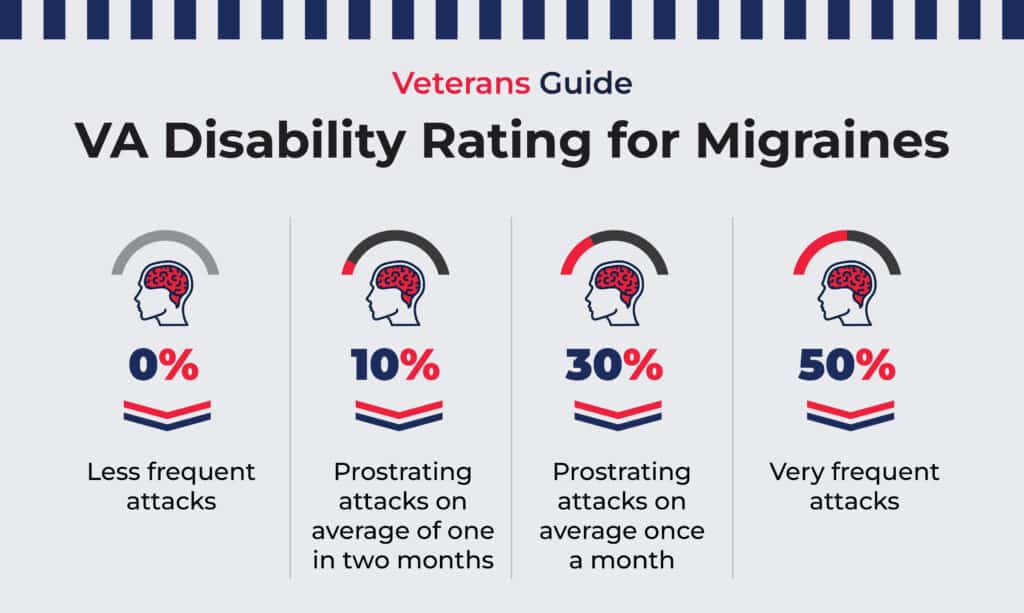VA Disability Rating for Migraines
- The VA rates migraines based on frequency, intensity, duration, and impact on the veteran’s ability to work, with the highest rating for migraines being 50%.
- Veterans must provide evidence, including medical records and possibly a Migraine Disability Benefits Questionnaire, to establish the extent and service connection of their migraines.
- Veterans with migraines may be eligible for Total Disability Individual Unemployability (TDIU) benefits if their migraines, alone or combined with other conditions, severely affect their ability to work.
- Migraines can be rated as a secondary disability if they are linked to other service-related conditions, affecting the overall disability rating.
It is not unusual for veterans to suffer from service-related migraines because of trauma from incidents like explosions or as a byproduct of other conditions, such as traumatic brain injuries or tinnitus. You can file a claim to receive a VA disability rating for migraines alone or as secondary to another condition.
Your disability rating depends on how often you have migraines, how debilitating they are, and how long they last. The highest VA rating for migraines is 50 percent. However, if you have migraines in conjunction with another disability and your combined rating is over 70 percent, you may qualify for additional benefits.
To get the disability rating you deserve for your migraines, you must include evidence establishing the extent of your headaches, the effects on your daily life and ability to work, and the link to your military service.
The maximum a veteran can receive for a migraine is a 50% disability rating. This is classified as migraines start generally debilitating. For less severe migraines, the rating would be slightly lower, but still veterans may be entitled to additional disability compensation for migraines.
The maximum a veteran can receive for a migraine is a 50% disability rating. This is classified as migraines start generally debilitating. For less severe migraines, the rating would be slightly lower, but still veterans may be entitled to additional disability compensation for migraines.
Veterans and Migraines
Migraines are moderate to severe headaches marked by pulsating, throbbing pain. They result from nerve fiber reactions in the blood vessels of the membranes protecting the brain and spinal cord. Some people experience shimmering “heat waves” or flashing lights, called auras, before or during migraines. Other symptoms include the following:
- Sensitivity to noise, light, and smell
- Vomiting
- Nausea
- Blurred vision
- Fatigue
The VA recognizes that veterans are more likely than civilians to develop migraines. Veterans have increased exposure to risk factors that lead to migraines, including combat stress and injuries such as traumatic brain injuries, concussions, or neck trauma. These injuries result from service-related incidents, such as explosions, falls, or other accidents.
How Does the VA Rate Migraines?
To receive disability benefits, you must have received an honorable discharge or a discharge under honorable conditions. You can receive disability benefits for injuries or illnesses suffered during active duty, active duty training, or inactive duty training.
If you qualify under those conditions, at least one of the following must be true to get a disability rating:
- You got injured or sick during military service and can link your migraines to that injury or illness.
- You had migraines before you joined the military, and your service worsened them.
- Your migraines didn’t surface until after you served, but you can show a link to your service.
The VA rates disabilities from 0 to 100 percent in increments of 10. It bases its ratings for migraines on the severity of your attacks, how long they last, and their effect on your ability to work. The ratings include the term “prostrating,” but the VA does not define it. “Prostrating” generally means the patient must lean back or lie down during migraines.
VA Disability Rating for Migraines
| 0% | Less frequent attacks |
| 10% | Prostrating attacks on average of one in two months over the last several months |
| 30% | Prostrating attacks on average once a month over the last several months |
| 50% | Very frequent attacks that are completely prostrating and prolonged and lead to severe economic inadaptability |

You must provide medical evidence supporting your claims for migraines. Keep a journal with the dates and times of your attacks to help your doctor and the VA determine when they are prostrating and if they are prolonged. If your migraines result from a specific incident, such as an explosion, include a copy of a military incident report or ask the VA to get one on your behalf.
Ask your doctor to fill out the VA Public Disability Benefits Questionnaire, or DBQ, for migraines. The VA does not require the form, but the agency has designed it so your doctor can list specific information about the severity of your migraine attacks, including duration and whether they are prostrating. Including this form with the medical records you submit can help speed up the process and ensure you get a proper rating.
TDIU and Migraines
Total Disability Individual Unemployability, or TDIU, is a VA program for people with service-related disabilities that stop them from attaining substantially gainful employment. If the VA grants your TDIU claim, you receive benefits at a 100-percent disability rating, even when your actual rating is lower.
There are two paths to TDIU eligibility:
- At least one service-related disability rated at 60 percent or more
- Two or more disabilities, with one rated at least 40 percent and a combined rating of 70 percent or higher
You must provide medical records or doctor’s notes to support your claim that you cannot work due to your migraines or their combination with other disabilities. You must also include the application for TDIU benefits and a request for employment information in your claim.
If your rating doesn’t meet the criteria for TDIU, you can try to get a rating change through the appeals process. There is also a chance that the VA Rating Board will determine that you are unemployable despite not meeting the usual requirements. In these cases, the Board sends a detailed statement to VA Compensation Service asking for extra consideration on your behalf.
Migraines as a Secondary Disability
Migraines are sometimes tied to other conditions, such as vertigo and tinnitus. The VA recognizes these as disabilities, and you can receive a separate rating for them even if it resulted from the same incident that led to your migraines.
When you have two or more disabilities, the VA combines your ratings to determine a score. They do not simply add them together, which could result in a rating over 100 percent. Instead, they use a table of combined ratings to create a score and then round that score to the nearest 10 percent.
For example, a 30-percent migraine rating and a 10-percent tinnitus rating result in a score of 37. This gets rounded up to give you a final disability rating of 40 percent. If you have more than two disabilities, the VA continues to use the chart to combine your ratings until it reaches a final disability rating.
- Post Traumatic Stress Disorder
- Chronic Adjustment Disorder
- Major Depressive Disorder
- Hearing Loss
- Nerve and Neurological Damage
- Skin Conditions
- Musculoskeletal Injuries
- Respiratory Conditions and Asthma
- Gastrointestinal Problems
- Heart Disease
- Genitourinary Conditions
- Eye Conditions
- Dental Conditions
- Endocrine Disorders
- Gynecological Conditions
- Hemic and Lymphatic Conditions
- Infectious Diseases and Autoimmune Disorders
How To Obtain VA Disability for Migraines?
You can claim benefits from the VA if you believe your migraines resulted from your military service. A successful claim results in monthly compensation and access to VA programs based on your disability rating. There are three ways to submit your claim:
- Fill out the online application by yourself or with the help of an advocate
- Fill out VA Form 21-526EZ and mail it to the VA Claims Intake Center
- Fill out the form and bring it to your nearest VA regional office
Be sure to include your VA and private medical records, including a DBQ specific to migraines. Attach supporting statements from people you served with, friends, family members, or others who can attest to your migraines and their effects.
Also include any military records supporting your position, such as incident reports related to your injury or condition and in-service medical records.
The VA may ask you to undergo a Compensation and Pension, or C&P, exam before assigning you a disability rating. They require this exam when you lack other sufficient evidence to support your claim.
To learn more about VA benefits for migraines, or if you have other VA disability questions, contact Veterans Guide for help.



